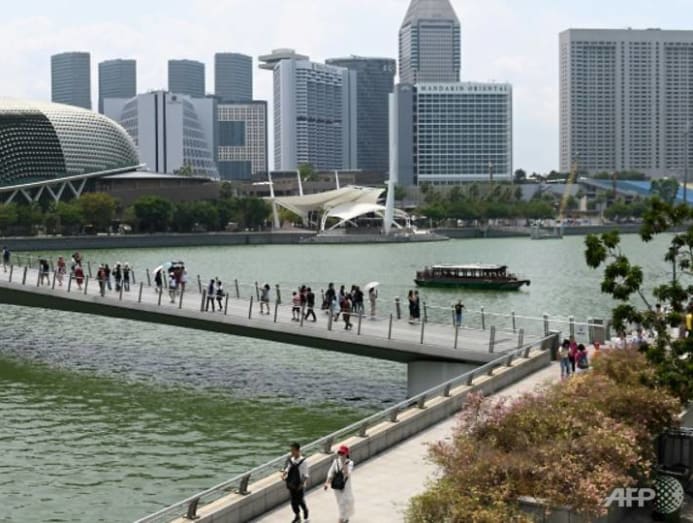Commentary: Latest climate change report is the most important by far. Here's why
Dr Winston Chow was involved in the recently released IPCC climate science report. He explains why this report communicates the consequences of climate inaction better than previous ones.

Singapore's Marina barrage. (Photo: iStock)
SINGAPORE: Over the past three years, approximately 250 experts in the Intergovernmental Panel on Climate Change (IPCC)’s Working Group I (WGI) writing team volunteered their time and expertise to author the sixth - and latest - assessment on the physical basis of climate change.
It is the first of a series of IPCC reports in each assessment cycle spanning approximately seven years, examining climate research undertaken since the last cycle ended in 2014.
The writing team faced considerable obstacles. The assessment cycle was extended because of the COVID-19 pandemic, which fundamentally changed how authors met and worked across borders and time zones in collaboratively writing multiple drafts.
Almost 80,000 comments on the drafts were submitted from expert reviewers and governments over the past three years; all had to be addressed for the report to pass the IPCC approval process.
They also faced the challenge of completing a report concise enough for policymakers seeking authoritative information on climate change, while simultaneously accounting for the explosion of climate literature published since 2014.
About 14,000 total citations to relevant literature were assessed - and even that voluminous amount doesn’t cover the staggering breadth of climate science research during that period.
As such, the approved report released on Monday (Aug 9) is a monumental feat and the authors’ efforts should be applauded.
CLEAR HUMAN INFLUENCE ON MORE FREQUENT EXTREME WEATHER EVENTS
While the report’s fundamental conclusion - that climate change is happening and that humans are causing it - isn’t new, there are three key takeaways worth highlighting.
First, stronger evidence has emerged of clear human influence on more frequent extreme weather events across the globe, such as rainfall, droughts, severe storms like cyclones, and from compound events like wildfires driven by heatwaves and dry conditions.
We can say with strong confidence that historical “natural” variability of the climate system alone can no longer explain most extreme weather events experienced since 2014.
Instead, human influence, through increased greenhouse gas (GHG) emissions and land cover change, is now the prime suspect.
AVERAGE GLOBAL TEMPERATURES WILL EXCEED PARIS AGREEMENT’S THRESHOLD GOALS
Second, it appears all but certain that average global surface temperatures, currently at 1.1 degrees Celsius above the baseline pre-industrial era in the 19th Century, will exceed the 1.5 and 2 degrees Celsius threshold goals of the 2015 Paris Agreement.
Without rapid cuts to the approximately 50 billion tonnes of carbon dioxide equivalent gases currently emitted worldwide per year, we will pass 1.5 degrees Celsius sometime early during the next decade.
Even the reduced emissions from COVID-19 lockdowns over the past 18 months will not slow future temperature increases; the temporary blip is more than offset by the momentum from decades of accelerating global GHG emissions that won’t abate.
Yet, the report also assesses that scenarios with stringent global GHG emissions cuts during this decade, resulting in net-zero emissions by 2050, can stabilise temperatures below 2 degrees Celsius - and as close as possible to 1.5 degrees Celsius - by 2100.
This small window of opportunity to meet the Paris Agreement goal, however, will continue shrinking every year without substantive action.

NET-ZERO EMISSION GOALS HAVE BECOME EVEN MORE CRITICAL
Third, the need for action is urgently critical since the report clearly articulates a bleak climate future without achieving the net-zero goal.
A useful analogy with the recently concluded Tokyo Olympics may help illustrate this point. Adding GHG emissions to the climate system and the resulting change in extreme weather is akin to an athlete’s health when continuously using performance-enhancing drugs.
Record-breaking extreme weather events like the heatwaves, severe storms, and wildfires that we’ve seen across the globe over the past few months are likely to occur more frequently in the years to come, just like record sporting performances from athletes’ consistent usage of human growth hormone or anabolic drugs.
As continued steroid use often leads to debilitating chronic health issues for athletes, the report also stresses long-term and potentially irreversible changes to our planet, such as the continued melting of massive Greenland and Antarctic glaciers leading to dangerous levels of sea level rise.
Just like drug overuse in sports can damage an athlete’s future health and lead to premature death, we must therefore be wary of uncontrolled GHG emissions and its detrimental risks to societies.
Indeed, these risks can be existential, as Prime Minister Lee Hsien Loong noted in his 2019 National Day Rally regarding the environmental and geopolitical threats of rising sea levels to Singapore.
Our cities are warm and will get warmer. But how can technology keep us cool and keep emissions down? Find out how on CNA's The Climate Conversations.
A NEW CLIMATE ATLAS TO SEE HOW REGIONS LIKE SOUTHEAST ASIA WILL FARE
In this IPCC assessment cycle, detailed information into climate risk assessment, particularly on climate hazards arising under different global warming levels (i.e., 1.5, 2 degrees Celsius or beyond), is available for discrete geographical regions like Southeast Asia.
While the report describes and assesses such risks for different regions in detail, one exciting development stands out.
The regional variations in climate - from historical data and from projected climate model simulations assessed by the IPCC - will be publicly available through an interactive online atlas.
Users can analyse and download the numerous datasets used in the report for their regions of interest, and access synthesised information for climatic impact drivers such as temperature, rainfall and sea level rise.
As an educator, it is often difficult to dynamically display the variety of potential climate futures for my students, especially at regional levels and over different time periods.
They - and their families and loved ones who live, work and play in Southeast Asia - are more invested in knowing how climate change affects them locally, which can be significantly different than the global “big-picture” impacts.
For instance, the atlas illustrates that some coastal Southeast Asian cities like Manila likely face greater risks from wet weather extremes and more intense tropical cyclones, while other cities in the region like Singapore instead face greater heat risks with each degree Celsius of additional warming.
Having this atlas will be an exciting communication tool to clearly illustrate concepts of climate science for students and for many other stakeholders affected by climate change, as well as demonstrate the regional outcomes of global action (or inaction) on GHG emissions.
SO, WHAT’S NEXT?
The report articulates the dire nature of the climate emergency we face, and provides important information for accelerating action towards the Paris Agreement goals in the 26th UN Climate Change Conference of the Parties (COP26) in Glasgow held this November.
For the IPCC, subsequent reports building on WGI’s work will be released next year from Working Group II (dealing with climate impacts, adaptation, and vulnerability) in February, Working Group III (on climate mitigation) in March, and a Synthesis Report from all Working Groups in September.
Taken together, these documents provide an important blueprint for people to understand what can be done to address the climate emergency we face.
However, our work as IPCC authors has one important caveat. While we objectively assess relevant science-based climate policy options for governments, we do not formally prescribe such policies in our reports.
As I tell my students, we climate scientists can authoritatively answer questions of whats, whys, and wherefores of climate change.
The important climate policy questions starting with “should”, however, have to be determined collectively by decision-makers in each country and the people who support them, based on the best information available.
Winston Chow is an Associate Professor of Science, Technology and Society at Singapore Management University. He is also a lead author for two urban chapters in the IPCC’s WG II assessment report due in February 2022 and a contributing author to the WG I report. The views expressed in this commentary are his own.







